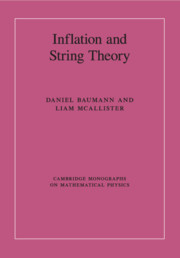Book contents
- Frontmatter
- Dedication
- Contents
- Preface
- Notation and conventions
- 1 Inflation: theory and observations
- 2 Inflation in effective field theory
- 3 Elements of string theory
- 4 What is string inflation?
- 5 Examples of string inflation
- 6 Conclusions and outlook
- Appendix A Mathematical preliminaries
- Appendix B The effective theory of inflation
- Appendix C Primordial perturbations from inflation
- References
- Index
2 - Inflation in effective field theory
Published online by Cambridge University Press: 05 May 2015
- Frontmatter
- Dedication
- Contents
- Preface
- Notation and conventions
- 1 Inflation: theory and observations
- 2 Inflation in effective field theory
- 3 Elements of string theory
- 4 What is string inflation?
- 5 Examples of string inflation
- 6 Conclusions and outlook
- Appendix A Mathematical preliminaries
- Appendix B The effective theory of inflation
- Appendix C Primordial perturbations from inflation
- References
- Index
Summary
Inflation is a well-understood phenomenon in quantum field theory coupled to gravity, and many field theories that support inflationary phases have been proposed. Nevertheless, deriving the inflationary action from a more fundamental principle, or in the context of a well-motivated parent theory, remains a central problem.
There are two approaches or perspectives that can be used to obtain a quantum field theory suitable for inflation. In the “top-down” approach, one begins with a complete theory in the ultraviolet (UV), such as string theory, and tries to derive inflation as one of its low-energy consequences. This undertaking is discussed at length in Chapters 4 and 5. The more conservative “bottom-up” approach starts from the low-energy (IR) degrees of freedom and parameterizes our ignorance about the UV theory. Both approaches arrive at an effective field theory (EFT) that is valid at inflationary energies, but they do so from opposite directions. The two approaches are complementary and can inform each other.
The outline of this chapter is as follows: in Section 2.1, we provide a general overview of the essential principles of effective field theory. We apply these concepts to inflation in Section 2.2, highlighting the sensitivity of inflation to Planck-scale physics in Section 2.3.
Principles of effective field theory
Natural phenomena occur across a vast range of length scales. Fortunately, in many cases one can analyze physical processes involving distinct scales by examining one relevant scale at a time. Figure 2.1 illustrates this logic using a few famous examples from the history of particle physics. For instance, at low energies, Fermi theory describes neutron–proton interactions by a fourfermion contact interaction with coupling constant GF = (293.6 GeV)−2. This theory is incomplete and breaks down (violates perturbative unitarity) at about 100 GeV. What actually happens close to 100 GeV is that we start to resolve the W-boson exchange interaction and Fermi theory is replaced by the electroweak theory of the Standard Model.
- Type
- Chapter
- Information
- Inflation and String Theory , pp. 33 - 73Publisher: Cambridge University PressPrint publication year: 2015
- 1
- Cited by



